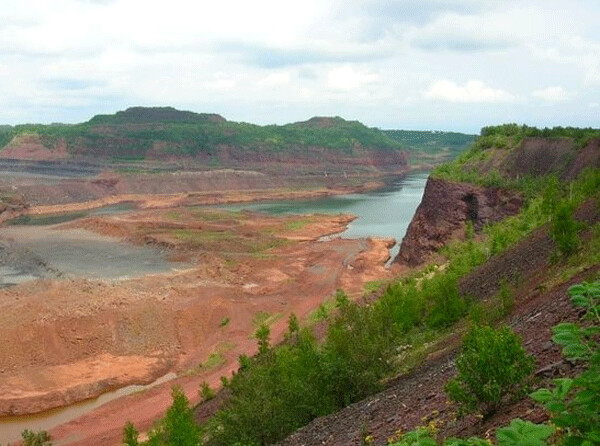News & Articles
Browse all content by date.

Mine dumps still dot the Iron Range, but with tree cover they look (until closely examined) like ordinary hills instead of the rusty red constructions that I remember marked landscape and horizon. I don’t want to romanticize, but before nature took its course terraced mine dumps had an exotic appearance. Seeing otherwise boring and ugly mine dumps nearly every day (and feeling my school jump when the mines shot rock) brought thoughts of supernatural power and images of Ancient Egypt where the distinctive Step Pyramid rose over the dull dusty plain of Sakkara (Saqqara). The Step Pyramid supposedly built as a tomb for Pharaoh Djoser was either a success or failure depending on how you lean, but it was the first of the pyramids that followed on the famous plateau of Giza.
Iron mining is no way glamorous as pulling gold from the ground, but imagining iron ore dumps as potential pyramids added a luster the envy of Indiana Jones when he was first beginning to dream doomed temples and lost Arks. My interest began just as it was being learned that the Step Pyramid was a complicated series of base and height expansions. Djoser or his next of kin liked the idea so they kept running with it. I don’t recall if the Step was ever covered in polished white limestone like the Giza numbers, but after a good old northern Minnesota snow storm a multi-tier mine dump dazzled better than anything in Egypt. My youthful imagination enjoyed conjuring images of the Range slowly transforming into a Pharaonic empire and a new age of pyramids would be born. In true Ranger fashion I knew with every dreamy vision our Iron Range pyramids would never be covered in anything soft and lowly as white limestone. That was unthinkable, not to mention limestone’s not very easy to come by up here. No, an Iron Range pyramid had to be clad in US made stainless steel. Nothing else would do.
You may hold what I’m writing about as silly or delusional, but I was not alone seeing pyramids for Northern Minnesota. Sometime in the 60’s an east coast publication lofty as Atlantic Monthly or Harpers ran an article proposing the very thing. I was not alone, though that was of little real comfort presenting visionary ideas to hard minded and practical miners. We could surely have built any number of attractive and impressive pyramids. I don’t believe building them was the problem. Where we lost the game was in lacking human Pharaoh material in need of a whopping big tomb. Why build it if you don’t need it? A review of Range groups showed little hope of a Pharaoh popping up in either the Scandinavian or Southern Slavs. Nice people, but not the sort interested in 400 foot tall stainless covered tombs. I tried to solve the “Find A Pharaoh” problem but never cracked that one. Perhaps my best scheme was to find Amelia Earhart and place her in a mine dump pyramid to be mourned and admired (along with Captain Noonan) for generations to come. But with Amelia missing then as now there wasn’t much hope in that Hail Mary attempt to bring off the miracle of pyramids for northern Minnesota.
I wouldn’t blame you or anyone being skeptical over pyramids for Minnesota. In plain fact I think we Minnesotans might be too nice to be pyramidal types proclaiming exceptionalism. You likely know the quip that if the Canyon Grand had been located in MN we’d be calling it the Pretty Nice Canyon. I appreciate Minnesota niceness, but being nice doesn’t mean it’s good. Indeed, turning nice instead of taking a stand can be corrosive by eating away at the value of forthright expression. Take the Hail Mary line from the last paragraph as an example. If we’re nice we could kindly and with due regard remove a religious usage that might be offensive to some other belief. The motive sounds OK, but are other beliefs so tender, weak, and vulnerable they need 360 degree safety padding so as not to be injured by a two word phrase? That position seems more demeaning in impact than anything a Hail Whoever might accomplish. Becoming ineffectual is a price of being too nice. An argument can be and is made that some expressions should be culled out for being discriminatory. Those arguments are perfectly correct because language is largely discriminatory by drawing lines and distinctions between the things words mean. Without discrimination language becomes useless; like this. Question, “Blah, blah, blah-blah-blah?” Answer, “Blah blah-blah.” Take away the discriminating nature of words and meaning goes with it.
There is, I know, much sincerity in efforts to clean language of hate and discrimination but before long this leads to fretting over time wasting worries. How much racism is insidiously passed along in the expressions “white bread” and “white sugar”? Is it less if you toast the bread or eat the entire sandwich including the crusts? How much bias and stereotype is in a sandwich? Is PBJ a safe and OK expression compared to a pork containing BLT? (BTW a PBJ is not free of suspicion from those of the public with nut allergies.) Verbal bullying has different forms. Some forms use expression to knowingly insult. Other bully forms are used intending to intimidate others into silence. There is quite a lot of gray and innocent material in between. In food as in words it should not be necessary to color our milk orange and ban white bread to save ourselves from possible offense. When there is misunderstanding there is the simple act of asking what was meant before hurling hand grenades of accusation. Caving in to word bullies we abandon reason in dialog to one-way strings of indictment.
Fortunate me; such controversy washes harmlessly over my head. Do I credit this to a lifelong love of bias free rye bread? In any event when I hear politicos go off in furies over the smallest of perceived issues I can’t help doodle that imagining pyramids for Minnesota is at least as sane and almost assuredly more productive.
| Tweet |


